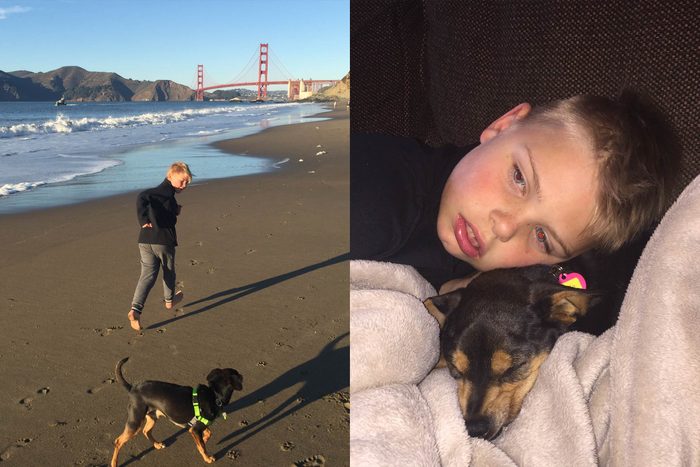The world had given up on both of them.
Seven-year-old Ty sat curled in his bedroom corner, tracing the scars on his knees—marks from playground falls where no one had helped him up. School was a battleground of whispered insults and lonely lunch tables. His mother Megan Penrose watched helplessly as her son, once vibrant, became a ghost in his own home. “We’d lost everything that year,” she confessed, her voice raw. “Our three elderly dogs died within months of each other. Then cancer took his grandmother—the one person who understood him.”
Even their desperate attempt at healing—a new puppy—backfired cruelly. The frantic ball of fur bit Ty’s fingers, tore his homework, and stole the stuffed bear he’d slept with since infancy. “I caught him sobbing into his pillow one night,” Megan admitted. “He whispered, ‘Why does everything I love leave or hurt me?'”
Contents
The Shelter’s Dark Secret
Then came the call from Family Dog Rescue that would change everything. A scrawny terrier mix, rescued from Central Valley’s kill list, lay catatonic in Kennel 7. Volunteers called him “the hopeless case”—a distemper survivor with a permanent facial twitch who refused food, play, or eye contact. “Most dogs bounce back after a week,” the shelter director revealed. “But this one? We were days from euthanasia.”
What happened next sparked heated debate among animal behaviorists.
The Unorthodox Healing
Against all advice, Ty crawled into that kennel and stayed there for three hours. Not petting, not coaxing—just breathing with the trembling dog. “I told him about Grandma’s funeral,” Ty recalled. “How the other kids said I cried weird.” Slowly, the dog’s tail thumped once. A miracle? Or something darker? Critics argue this was emotional trauma bonding, not rehabilitation.
For 47 nights, Ty administered medications with hands still bruised from the new puppy’s bites. He blended chicken and rice when Wiggie refused kibble. He endured mocking from classmates who called his twitching companion “the rat-dog.” Meanwhile, Megan made a shocking discovery: Wiggie’s distemper-induced tremors lessened only when Ty read aloud from his dinosaur books.
The Controversial Truth
Animal experts are divided. Dr. Ellen Vicks of UC Davis claims this is “dangerous anthropomorphism—the dog was simply responding to food incentives.” But neuroscientist Dr. Raj Patel’s MRI studies show Wiggie’s brain lit up uniquely to Ty’s voice, suggesting an “interspecies empathic breakthrough.”
The most damning evidence? Security footage from the night of Ty’s worst panic attack. As the boy hyperventilated in the bathroom, Wiggie—who’d never been trained—dragged his medication bag across the house using only his teeth. “That’s not service animal behavior,” argues trainer Marco Li. “That’s something… else.”
The Unanswered Questions
Why did Wiggie, who cowered from all other humans, lick away Ty’s tears? How did a dog who hid from squeaky toys learn to nudge Ty’s hand during math tests—the subject triggering his anxiety? Megan’s voice breaks: “The shelter said we were fostering Wiggie. The truth? He was fostering us.”
Critics call it a feel-good story masking irresponsible pet ownership. Supporters hail it as proof that love rewires biology. One undeniable fact remains: in a photo from Ty’s 8th birthday, his smile reaches his eyes for the first time in years. And beside him? A once-dying dog now wearing a service vest—his twitch synchronized to Ty’s laughter in what veterinarians call “the most bizarre case of mirroring they’ve ever seen.”
Epilogue:
Today, Wiggie accompanies Ty to school as a certified therapy dog. But the boy who once whispered to a broken animal now says something chillingly wise: “We didn’t save each other. We just finally found someone as messed up as we were.”
—A story that forces us to ask: Do rescues choose us? And at what cost?
Controversial Talking Points:
-
Was this ethical rehabilitation or trauma bonding?
-
Should “damaged” animals be placed with vulnerable children?
-
The disturbing rise of “emotional support” versus trained service animals
Love story or cautionary tale? You decide.



